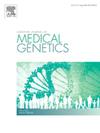描述不清的表型增加了罕见病的不幸。
IF 1.7
4区 医学
Q3 GENETICS & HEREDITY
European journal of medical genetics
Pub Date : 2025-10-01
Epub Date: 2025-08-07
DOI:10.1016/j.ejmg.2025.105034
引用次数: 0
摘要
在罕见病的表征中,一个经常被忽视的问题是公认的表型的偶然性和进化性。在下一代测序和基因型优先的患者护理方法的时代,我们通过对阿拉吉尔综合征的历史概述说明了表面表型描述的陷阱。这些反思使我们提出了一系列改善表型描述的建议,即鼓励和规范病例报告,并创建包括随访数据的病例数据库。本文章由计算机程序翻译,如有差异,请以英文原文为准。
Poorly described phenotypes add to the misfortune of rare diseases.
An often overlooked problem in the characterization of rare diseases is the contingent and evolving nature of accepted phenotypes. In the era of next-generation sequencing and genotype-first approaches to patient care, we illustrate the pitfalls of superficial phenotype descriptions via a historic overview of Alagille syndrome. These reflections lead us to a series of recommendations to improve phenotype descriptions, namely to encourage and standardize case reports and create case databases including follow-up data.
求助全文
通过发布文献求助,成功后即可免费获取论文全文。
去求助
来源期刊
CiteScore
4.10
自引率
0.00%
发文量
193
审稿时长
66 days
期刊介绍:
The European Journal of Medical Genetics (EJMG) is a peer-reviewed journal that publishes articles in English on various aspects of human and medical genetics and of the genetics of experimental models.
Original clinical and experimental research articles, short clinical reports, review articles and letters to the editor are welcome on topics such as :
• Dysmorphology and syndrome delineation
• Molecular genetics and molecular cytogenetics of inherited disorders
• Clinical applications of genomics and nextgen sequencing technologies
• Syndromal cancer genetics
• Behavioral genetics
• Community genetics
• Fetal pathology and prenatal diagnosis
• Genetic counseling.

 求助内容:
求助内容: 应助结果提醒方式:
应助结果提醒方式:


